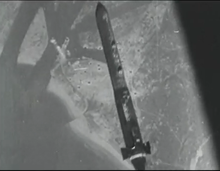| Disney bomb | |
|---|---|
 A Disney bomb just after release | |
| Type | Bunker buster bomb |
| Place of origin | United Kingdom |
| Service history | |
| In service | 1945–46 |
| Used by | United States Army Air Forces |
| Wars | World War II |
| Production history | |
| Designer | Edward Terrell |
| Designed | 1943 |
| Manufacturer | Vickers Armstrong[1] |
| Specifications | |
| Mass | 4,500 lb (2,000 kg) |
| Length | 16 ft 6 in (5.03 m)[Note 1] |
| Diameter | Body: 15 in (380 mm) Tail 17 in (430 mm) [Note 2] |
| Warhead | Shellite[2] |
| Warhead weight | 500 lb (230 kg)[2] |
Detonation mechanism | Base fuze |
| Propellant | Cordite |
Launch platform | Boeing B-17 Flying Fortress[3] |
The Disney bomb, also known as the Disney Swish,[4] officially the 4500 lb Concrete Piercing/Rocket Assisted bomb was a rocket-assisted bunker buster bomb developed during the Second World War by the British Royal Navy to penetrate hardened concrete targets, such as submarine pens, which could resist conventional free-fall bombs.
Devised by Royal Navy Captain Edward Terrell, the bomb was fitted with solid-fuel rockets to accelerate its descent, giving it an impact speed of 990 mph (1,590 km/h)—substantially beyond the 750 mph (1,210 km/h) free-fall impact velocity[5] of the 5-tonne Tallboy "earthquake" bomb for comparable purposes.
The Disney could penetrate 16 ft (4.9 m) of solid concrete before detonating. The name is attributed to a propaganda film, Victory Through Air Power, produced by the Walt Disney Studios, a division of The Walt Disney Company, that provided the inspiration for the design.
The Disney bomb saw limited use by the United States Army Air Forces in Europe from February to April 1945. Although technically successful, it initially was insufficiently accurate for attacking bunker targets. It was deployed late in the war and had little effect on the Allied bombing campaign against Germany.
- ^ Project Ruby 1946, p. 25
- ^ a b USSTAF Armament Memorandum 1945, pp. 1–2
- ^ Keefer 1947
- ^ Cite error: The named reference
CB57was invoked but never defined (see the help page). - ^ Ellis, John (1998). One Day in a Very Long War. Jonathan Cape. p. 297. ISBN 978-0-22404-244-4.
Cite error: There are <ref group=Note> tags on this page, but the references will not show without a {{reflist|group=Note}} template (see the help page).